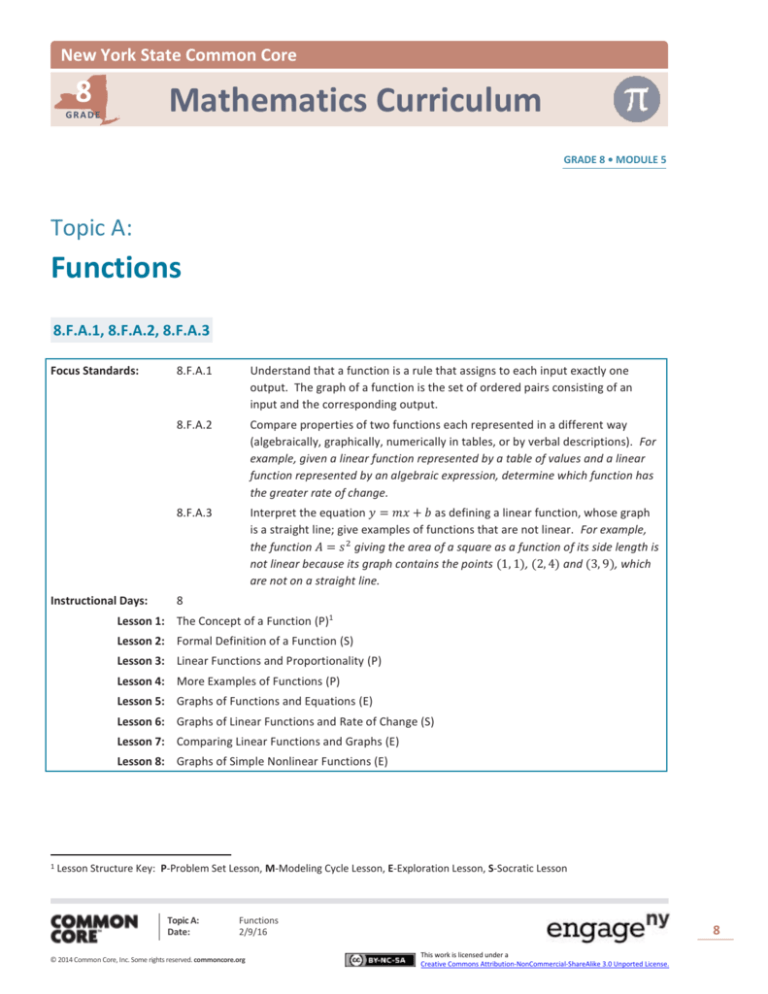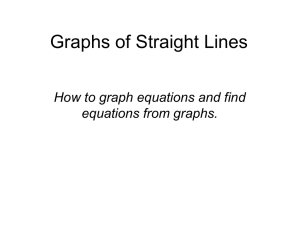
New York State Common Core
8
Mathematics Curriculum
GRADE
GRADE 8 • MODULE 5
Topic A:
Functions
8.F.A.1, 8.F.A.2, 8.F.A.3
Focus Standards:
Instructional Days:
8.F.A.1
Understand that a function is a rule that assigns to each input exactly one
output. The graph of a function is the set of ordered pairs consisting of an
input and the corresponding output.
8.F.A.2
Compare properties of two functions each represented in a different way
(algebraically, graphically, numerically in tables, or by verbal descriptions). For
example, given a linear function represented by a table of values and a linear
function represented by an algebraic expression, determine which function has
the greater rate of change.
8.F.A.3
Interpret the equation 𝑦 = 𝑚𝑥 + 𝑏 as defining a linear function, whose graph
is a straight line; give examples of functions that are not linear. For example,
the function 𝐴 = 𝑠 2 giving the area of a square as a function of its side length is
not linear because its graph contains the points (1, 1), (2, 4) and (3, 9), which
are not on a straight line.
8
Lesson 1: The Concept of a Function (P)1
Lesson 2: Formal Definition of a Function (S)
Lesson 3: Linear Functions and Proportionality (P)
Lesson 4: More Examples of Functions (P)
Lesson 5: Graphs of Functions and Equations (E)
Lesson 6: Graphs of Linear Functions and Rate of Change (S)
Lesson 7: Comparing Linear Functions and Graphs (E)
Lesson 8: Graphs of Simple Nonlinear Functions (E)
1
Lesson Structure Key: P-Problem Set Lesson, M-Modeling Cycle Lesson, E-Exploration Lesson, S-Socratic Lesson
Topic A:
Date:
Functions
2/9/16
© 2014 Common Core, Inc. Some rights reserved. commoncore.org
8
This work is licensed under a
Creative Commons Attribution-NonCommercial-ShareAlike 3.0 Unported License.
NYS COMMON CORE MATHEMATICS CURRICULUM
Topic A
8•5
Lesson 1 relies on students’ understanding of constant rate, a skill developed in previous grade levels and
reviewed in Module 4 (6.RP.A.3b, 7.RP.A.2). Students are confronted with the fact that the concept of
constant rate, which requires the assumption that a moving object travels at a constant speed, cannot be
applied to all moving objects. Students examine a graph and a table that demonstrate the nonlinear effect of
gravity on a falling object. This example provides the reasoning for the need of functions. In Lesson 2,
students continue their investigation of time and distance data for a falling object and learn that the scenario
can be expressed by a formula. Students are introduced to the terms input and output and learn that a
function assigns to each input exactly one output. Though students will not learn the traditional “vertical-line
test,” students will know that the graph of a function is the set of ordered pairs consisting of an input and the
corresponding output. Students also learn that not all functions can be expressed by a formula, but when
they are, the function rule allows us to make predictions about the world around us. For example, with
respect to the falling object, the function allows us to predict the height of the object for any given time
interval.
In Lesson 3, constant rate is revisited as it applies to the concept of linear functions and proportionality in
general. Lesson 4 introduces students to the fact that not all rates are continuous. That is, we can write a
cost function for the cost of a book, yet we cannot realistically find the cost of 3.6 books. Students are also
introduced to functions that do not use numbers at all, as in a function where the input is a card from a
standard deck, and the output is the suit.
Lesson 5 is when students begin graphing functions of two variables. Students graph linear and nonlinear
functions, and the guiding question of the lesson, “Why not just look at graphs of equations in two
variables?”, is answered because not all graphs of equations are graphs of functions. Students continue their
work on graphs of linear functions in Lesson 6. In this lesson, students investigate the rate of change of
functions and conclude that the rate of change for linear functions is the slope of the graph. In other words,
this lesson solidifies the fact that the equation 𝑦 = 𝑚𝑥 + 𝑏 defines a linear function whose graph is a straight
line.
With the knowledge that the graph of a linear function is a straight line, students begin to compare properties
of two functions that are expressed in different ways in Lesson 7. One example of this relates to a
comparison of phone plans. Students are provided a graph of a function for one plan and an equation of a
function that represents another plan. In other situations, students will be presented with functions that are
expressed algebraically, graphically, and numerically in tables, or are described verbally. Students must use
the information provided to answer questions about the rate of change of each function. In Lesson 8,
students work with simple nonlinear functions of area and volume and their graphs.
Topic A:
Date:
Functions
2/9/16
© 2014 Common Core, Inc. Some rights reserved. commoncore.org
9
This work is licensed under a
Creative Commons Attribution-NonCommercial-ShareAlike 3.0 Unported License.







